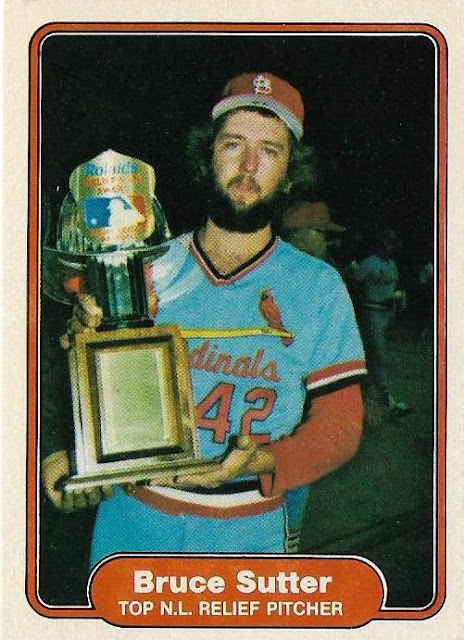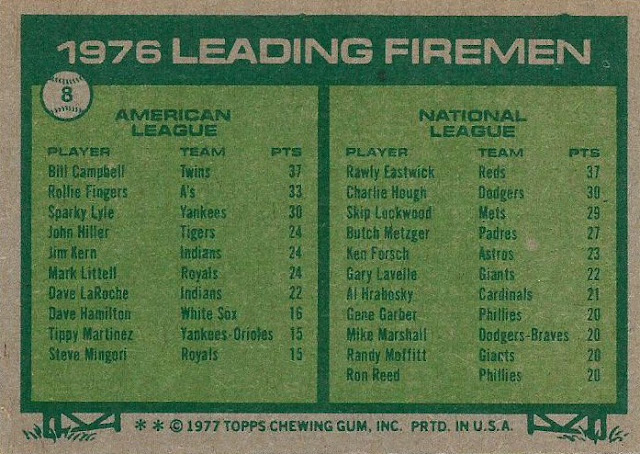The other day I was talking to a co-worker who is approximately my age and we were discussing the commercials we'd see on sports broadcasts when we were kids.
Naturally, we talked about the "Less Filling/Tastes Great" Miller Lite beer commercials because those goofy ads appealed to young viewers, unlike the boooring Miller Beer or Lowenbrau commercials that usually showed "old" guys in a fishing boat or adults toasting at a family gathering. I couldn't wait until those ads were off the TV.
Talk moved to the commercials that I remember showing up during the seventh inning stretch on NBC's airing of the Game of the Week on Saturdays. I recall the Rolaids Relief Man Award commercials airing at that time, along with Johnny Bench hawking Krylon spray paint ("no runs, no drips, no errors').
I tried to find a Rolaids Relief Man video from that time, but apparently '70s videos simply are not all that available. Most of what I found were the Old Spice commercials that aired during the seventh inning beginning in the early 1980s. I'm sure those of you watching games at that time recall those graphics:
The Old Spice seventh-inning breaks would devote time to remembering old stars of the past, and then later it would feature a contemporary player. But none of this did me any good, because I wanted to see the Rolaids Relief Man award and the standings that I seem to recall them showing and, of course, that fire hat award that you saw Bruce Sutter holding at the top of the post.
"Why a fire hat?" a younger fan must be wondering.
Yes, why indeed.
Sit down for a story.
The reason is that relief pitchers -- specifically what later became known as the "closer" -- used to be called "firemen." The reason for that was that usually these relievers only came into the game when there was trouble brewing, runners on base in late innings and such. That's how the best relievers were used back in the '70s -- to put out the fire. Closers today often appear with no one on base, no threat at all (and often proceed to start fires all by themselves). But back then, the main reliever's job was to appear only at the sign of trouble.
I grew up knowing those relievers as "firemen". But I haven't heard the term in a long time. I tried to figure out when that phrase began and also when it disappeared, but the best I could do was approximate both the beginning and the end.
Going to my baseball cards, it was easy to see when baseball's firemen grew into prominence.
The 1973 Topps set was the first to add another leader category and leader card to its leaders subset. The leader subset had been a tradition since the mid-1960s but before it stuck strictly to the most familiar stats: home runs, RBIs, batting average, victories, strikeouts and earned run average (It was always interesting to me that Topps began devoting a leader card to stolen bases but didn't bother making stolen bases a stat on the back of each player's card until years later).
But saves became an official stat in 1969. The points that you see on that 1973 "Leading Firemen" card denote the primitive way the top relievers of the day were evaluated. Relievers received two points for each relief victory or save and were subtracted a point for each relief loss. It was ridiculous to reward a fireman/closer for wins, as that signified the pitcher lost the lead at one point. But that's what we had and Topps rode it for all it was worth.
It is interesting that there is no mention on these cards what a "fireman" is. If I was a young fan coming into the game at that time, I would probably wonder why in the world they are calling baseball players firemen. But I guess that's how ingrained the term was at the time. I mean, I knew why and I was a kid then.
Each of the Leading Firemen cards showed the leaders on the back, much like the other leader cards, but they gave the calculations, too. Look at the bizarre win totals for the 1974 leaders, 17 for John Hiller, 15 for Mike Marshall. The save totals, as people who followed baseball know, were much lower at that time. It took switching from "fireman" to "closer" for save totals to soar.
The leader point totals returned to the front of the Leading Fireman card in the 1976 set. There's a reason for that, which you'll see in a minute.
This is also only one of two leader cards in the 1976 set that isn't shown in a pyramid format with the first-, second- and third-place finishers. Perhaps the point totals prevented Topps from using the pyramid layout for the relievers.
That is the back for the '76 card. Instead of the top 10 for each league, it shows the winners for the previous 15 years. I don't know if the reliever standings were compiled with the "two points for save or relief win/minus one point for relief loss" formula for all of these years. I had always associated the point formula with the Rolaids award, but I don't think Rolaids was associated with the top reliever for this long.
But this gives you a good idea that relievers were known as "firemen" long before the 1970s.
By the 1977 set, Topps had dispensed with the calculations for the leaders on the back. I guess everyone knew how the point totals were arrived at, I'm sure the Rolaids Relief Man commercials were in full force by then.
Topps acknowledging the Leading Firemen continued through the 1970s with leader cards in 1978 and 1979. It was Rollie Fingers' heyday.
But I found something interesting that I had never known before.
There is no 1980 Topps Leading Fireman card. There is a leaders subset that year but they simply left off the relief pitcher card.
"This is it!" I thought. "This is where the 'firemen' nickname disappears."
But that wasn't the case.
Rollie Fingers and the Leading Firemen were back in the 1981 Topps set.
The calculations on the reverse were back, too, although actually they returned in the 1979 Topps set.
OK, here we are.
No sign of "firemen" at all with 1982 Topps. Instead, it's "Leading Relievers".
This must be the end.
Also, side note, Bruce Sutter was deprived of appearing on a leader card as a Cub when Topps did not produce a reliever leader card in the 1980 set (also the Rangers' Jim Kern is forever missing his once chance to appear on a leader card). But Sutter more than made up for it as a Cardinal.
Leading Firemen! It's back!
It's really back!
There is a reference to this particular Leading Firemen group in an old "This Week in Baseball" clip on YouTube.
It's interesting that Rolaids was never mentioned on any of these cards. Rolaids had done such a good job of tying itself to the top relief pitcher honor on TV that it seems almost impossible to mention the award without also mentioning Rolaids.
So, as far as cards go, there is evidence of "fireman" being used for the leading relievers from 1972 through 1983/84 with an exception for 1980 (no card) and 1982 ("fireman" changed to "reliever").
But as far as when that term died out on baseball cards, I can't figure out an exact year.
That's because not only did "fireman" as a nickname disappear but also league leaders cards disappeared.
I don't know why Topps did this -- it was far before the internet arrived and everyone could find baseball stats on their computer instead of baseball cards -- but it scrapped league leader subsets beginning with the 1985 set. What had been tradition every year for 20 years was discarded leaving collectors in the dark over who was in fourth place in the American League in RBIs the preceding year.
To me, the late 1980s Topps sets have something missing, and that missing thing is the league leader cards that often began each Topps set.
With a few exceptions here and there (Collectors Choice in the mid-1990s, for example), leaders cards were uncool for years until they popped up again early in the 21st century.
That made me curious about what Topps was calling the leaders cards that showed the top relievers.
Of course, it was the very practical and matter-of-fact "saves."
Topps leaders cards strung together another run until 2017. Then, once its Big League brand arrived, Topps threw the leaders into that set. And, yes, the Big League set calls the top relievers "Saves Leaders". Firemen is gone for good. (In 1994, Ultra put together a throwback insert set of individual pitchers called "Ultra Firemen").
Funny little nicknames for baseball tasks have somewhat disappeared from the game today. Even though the name has changed to "closer" there was no leader card with "Leading Closers" or "Leading Door-Closers" as far as I know. Baseball is too big of a business now -- too important -- for funky little fireman names or awards with fire hats on them.
But there are still references to that old nickname on cards every once in awhile.
Thank goodness for Jeff Montgomery.























Comments
The '94 Fleer Ultra has a Firemen subset with Dennis Eckersley and Mitch Williams among others. It featured top relievers superimposed on a fire engine.
2. This is making me think about the late 1980s, the lack of leader cards, and how Topps put out the mini leaders set from 1986 through 1990. I haven't looked at the minis set in earnest in decades but now I'm wondering if those mention saves or firemen.
3. This post also makes me want to take a deep dive at 1985 Topps and how it, more than any other set, seems to be the true beginning of the junk era. No league leaders. Yes to Olympics and pre-rookie cards. Yes to draft picks. It exists right outside my consciousness since I never got a lot of them as a kid but it also feels like a true boundary on the era, not fitting in well with either the sets before it or the sets which came after.
I mentioned the '94 Ultra set near the end of the post.
I believe in 1979 Jim Kern and Mike Marshall tied for the lead in the AL Fireman of the Year standings, although most sites I visited mentioned Kern only. At any rate, Topps could've gotten by with showing just Kern.
I like the lists that show teams with 2 Firemen in the Top Ten. Won't see that any more.
League Leaders cards are in 2018 and 2019 Series One, though as a bit of a stealth card with just a single player on the front. 2020 Series One is too boring for me to recall if that continued along this year.
Big League has _a lot_ of Leader cards. Including some brand new categories never seen on baseball cards before. Too bad I was unable to buy much of it this year.
Also, now I remember Mike Marshall stopped appearing in the Topps set sometime in the late 1970s. This makes sense why there was not a fireman leader card in the 1980. Could not use Marshall's likeness on a card.